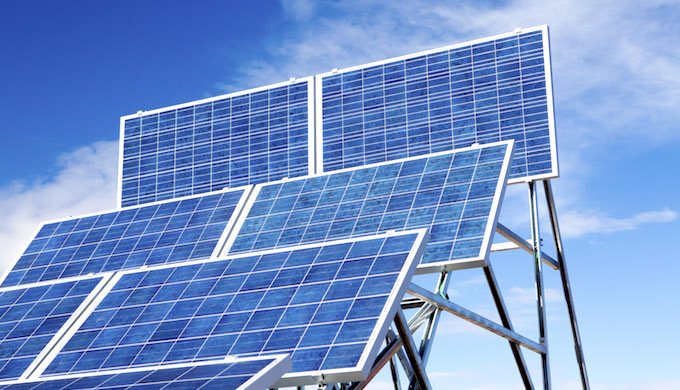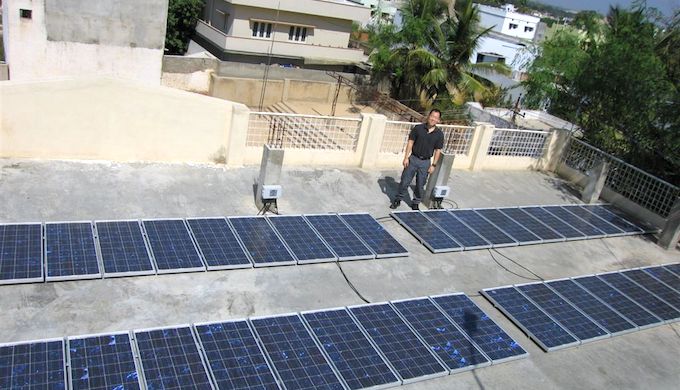Backed by strong policy measures and a buoyant solar sector, India is making impressive strides in this sphere of renewable energy

Solar power is rising rapidly in India. (Photo by NAIT)
The year 2016 has been extremely eventful for the clean energy sector in India. The share of renewable energy (RE) in total power generation increased from 4.97% in 2012-13 to about 5.7% by last February, according to data from the Central Electricity Authority, the country’s apex power agency. Unveiling of the world’s largest solar plant in Tamil Nadu, a USD 1 billion loan from the World Bank for solar power and over 20 countries signing a framework agreement to the International Solar Alliance, pioneered by India and France, in November are some other notable successes.
“India is on track to install more than 10 GW of renewables per year from 2017 as large-scale renewables, rooftop solar and off-grid sectors show impressive growth,” Bloomberg New Energy Finance (BNEF) said last month in a report titled Financing India’s Clean Energy Transition.
Total annual investments in utility-scale projects crossed the USD 10 billion mark last year. The Indian government’s “175 GW renewables by 2022” target includes 135 GW of utility-scale projects. This implies that cumulative capacity would have to increase more than three times between 2016 and 2022, from 39 GW in 2015 to 135GW, requiring an investment of nearly USD 100 billion at an average of USD 14 billion every year, the report points out.
Indian investment
“We need around USD 1 million per MW for solar and for installing other RE in the country. Of this, usually 30% will be equity and the rest is likely to be debt finance,” an official in the Ministry of New and Renewable Energy (MNRE) told indiaclimatedialogue.net. “If we include investment from overseas, by 2022, the amount of money invested in RE is likely to be USD 130 billion.” He declined to be named.
Opinions vary across the sector on meeting the target of 175 GW. The number could be too ambitious for a country like India, says Chandrashekhar Mishra, managing director, Canyon Consultancy Pvt. Ltd, which provides clean energy solutions. “Solar being an intermittent power, we are not ready in terms of grid availability and stability,” Mishra told indiaclimatedialogue.net.
On the other hand, Krishnan Pallassana, India Director, The Climate Group, an international non-profit, says that the country is now ready to meet its renewable target, thanks to aggressive efforts by the government and a positive market response to such measures. “This also coincides with the cost parity that solar power has with conventional power,” he said, “which has resulted in increased renewables uptake and investments into solar power projects.”
Rise of solar
Owing to decentralized generation systems, solar has started coming up as a commodity. Also, it is no longer restricted to subsidy from the government. As of now, around 20 GW of solar power is in the pipeline. “The tariff policy in 2016 has enabled the renewable purchase obligation to increase to 8% by 2022. This means 8% of the total power in India will be generated by solar,” said the MNRE official.
Recently, a solar entrepreneur was in the news for bidding for a peeoject in Rajasthan at INR 3 per unit, the lowest in the world so far and considerably lower than the rates charges by coal, gas and oil fired power plants.
With the rates of solar reducing considerably, a parallel market has emerged where people are motivated to use it. In Bihar, for instance, stores selling solar appliances are doing brisk business and in Bhagirath Palace Market, Chandni Chowk, Delhi, people are able to buy panels easily, he said.
Additionally, the emphasis to expand grid connectivity, ensure universal access and build adequate infrastructure to integrate green energy into the national grid, will further the solar energy agenda in the country, feels Pallassana.
On the policy front, in order to achieve 100 GW of solar capacity installation by 2022, schemes launched by MNRE include setting up exclusive solar parks; development of a power transmission network through the Green Energy Corridor Project; identification of large government buildings for rooftop projects; making rooftop solar and 10% RE mandatory for large office buildings under the solar mission statement and guidelines for development of smart cities; raising tax free solar bonds; making rooftop solar a part of housing loan by banks; incorporating measures in the Integrated Power Development Scheme for encouraging distribution companies and making net-metering compulsory; and raising funds from bilateral and international donors and approaching the Green Climate Fund to achieve the target.
Rooftop prospects
Rooftop solar, according to the BNEF report, has become the fastest growing renewable power sub-segment in India’s clean energy market. Starting from a small base, annual installations have increased by nearly three times (from 72 MW to 227 MW) in the past three financial years and this trend is expected to continue.
Shantanu Jaiswal, lead analyst, India, BNEF says, “We certainly see the momentum going strong for the next few years. After that the annual growth rate may slow down due to a larger base than now, but the sector will continue to build more projects every year.”

Many new projects of rooftop solar are expected. (Photo by FJL)
Manoj Gupta, Vice-President, Solar, Fortum India, a power producer, is positive that the rooftop solar market has great potential. “It is reassuring to see the Indian government make efforts to address the key challenges to drive solar adoption across the nation,” he said. “Harnessing solar power via rooftop panels is gradually emerging as an attractive option for industries, the commercial belt and going forward, to households and smaller organisations.”
The Indian government, Gupta adds, has asked states to prepare action plans with year-wise targets to introduce RE technologies and install solar rooftop in order to achieve 175 GW of renewable power by 2022. “Fortum India is closely evaluating the rooftop business model for viability to start with respect worthy counter parties as soon as possible.”
“Even though we have witnessed the adoption increasing, we believe the required thrust is yet to come,” Gupta told indiaclimatedialogue.net.
Canyon’s Mishra believes that 40 GW rooftop solar is the only target achievable for a country like India that is highly populated. “If every house can absorb 3 to 5 kWp rooftop solar projects, this will help achieve the target.” he says.
Jaiswal suggests that to increase the participation of residential consumers in building small solar projects, there should be active reach outs through various media sources to explain the immediate economic benefits of installing a PV panel on rooftops. “The government can also promote this by simplifying and automating the subsidy collection process.”
On the investment front, the small and rooftop solar sector will need another USD 50 billion to meet the its 40 GW target. In this context, the World Bank Board’s approval of an additional grant of USD 22.93 million to enhance the installed capacity of Grid-connected Rooftop Solar Photovoltaic (GRPV) programme and strengthen the capacity of relevant institutions for widespread installation of GRPV is likely to aid the industry.
Renewable energy grids
Small renewable grids can meet the subsequent increase in power demand in off-grid areas. These have started to provide 76,000 rural households with scheduled power since 2013. Small energy grids can help unlock the commercial potential of micro enterprises in rural India. Once people have their own solar devices or off-grid power, they need not rely on low quality and polluting alternatives such as kerosene and unreliable grid electricity, the report states.
Jaiswal explains that as people move up the energy ladder, their electricity consumption increases due to addition of new electrical appliances. This increase may not be met by solar home systems. Also, commercial activities in rural parts of the country need access to electricity for reliable and high voltage applications, which are best met by mini grids. “Therefore, all forms of off grid power such as mini grids, solar home systems and solar lighting devices are needed to provide electricity.”
However, the MNRE official holds that grid extension is financially viable and the power situation has improved. As a result, shortage has reduced drastically. “With surplus power, the question arises as to how can we reach areas that do not have access to the grid or have limited access.”
Pallassana of Climate Group suggests that it is time for India to usher a new narrative around energy access. It is no more about on-grid or off-grid, central or state or large utilities versus small energy service companies. India’s energy dream has to follow an integrated approach wherein the centralised power generators, large RE producers, national grid and neighbourhood off grid panels are offering the solution in totality.
“We are moving into an era where the consumer also becomes a producer and there is bound to be a bi-directional flow of electrons from and to the grid,” he says. “This foretells an exciting future of smart, digital, balancing grid to ensure efficient, reliable and affordable power to people.”
Room for improvement
Despite policies being initiated to take the RE sector ahead, other measures are also required for consistent growth, industry insiders say.
Jaiswal feels that the biggest risk for renewable projects comes from the poor financial health of power distribution companies. “The state policies need to address the situation where there might be a pushback from discoms (power distribution utilities) in allowing more renewable projects from being built. Already, there are technical limits placed by some states which restrict the capacity of rooftop solar projects that can be built by residential consumers.”
With regard to rooftop solar, Mishra suggests measures such as making it easy for households to get the no-objection certificate from discoms and state utilities. “Easy availability of all types of net meters with discoms/state utilities and waiving of Chief Electrical Inspectorate General approval from rooftop solar projects up to 100 kWp also need to be taken up,” he adds. “Clarity on subsidy is a must as customers are not sure of getting it due to complex procedures.”
